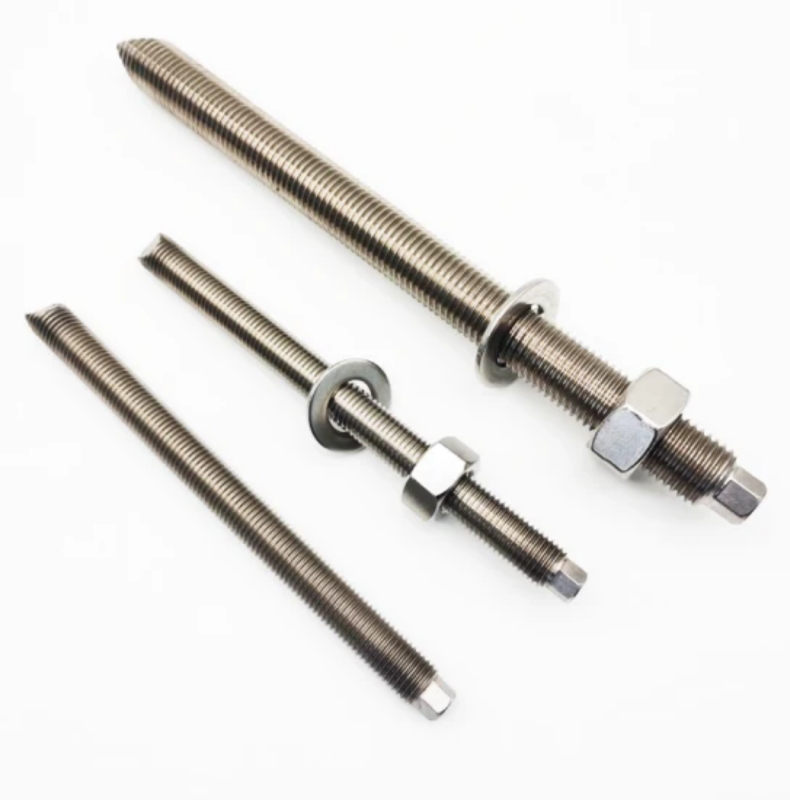### General Anchor Fastener Tags 1. **Type**: Identifies the anchor type (e.g., mechanical, chemical, expansion, undercut, screw, sleeve, drop-in, adhesive). 2. **Material**: Specifies the material composition (e.g., carbon steel, stainless steel, zinc-plated steel, epoxy, polyester resin). 3. **Diameter**: The diameter of the anchor, which can influence the load capacity. 4. **Length**: Length of the anchor, which affects embedment depth and the strength of the attachment. 5. **Load Capacity**: Maximum load the anchor can support, often specified in terms of tension and shear loads. 6. **Drill Bit Size**: Recommended drill bit size for pre-drilling holes for the anchors. 7. **Minimum Embedment Depth**: The minimum depth at which the anchor must be installed to achieve the stated load capacity. 8. **Corrosion Resistance**: Indicates the anchor's resistance to environmental conditions that can cause corrosion. 9. **Application**: The specific applications or environments where the anchor is best used (e.g., indoor, outdoor, wet conditions, seismic applications). 10. **Certifications/Standards**: Compliance with international standards or certifications (e.g., ASTM, ETA, ICC-ES). ### Chemical Anchor Fastener Tags 1. **Resin Type**: Type of resin used (e.g., epoxy, polyester, vinylester), which affects the chemical resistance and bonding strength. 2. **Cure Time**: The time required for the chemical anchor to fully cure or harden. 3. **Working Time**: The time period during which the chemical anchor can be adjusted or manipulated after installation but before it cures. 4. **Temperature Range**: The range of temperatures in which the chemical anchor can be effectively installed and maintained. 5. **Shelf Life**: The period during which the chemical components remain usable before mixing. 6. **Mixing Ratio**: The required proportion of resin to hardener or activator, if applicable. 7. **Usage Instructions**: Specific instructions for mixing, applying, and curing the chemical anchor. 8. **Packaging**: The form in which the chemical anchor is sold (e.g., cartridges, sachets, bulk).
Chat with us on WhatsApp
×
This is your website preview.
Currently it only shows your basic business info. Start adding relevant business details such as description, images and products or services to gain your customers attention by using Boost 360 android app / iOS App / web portal.

2024-02-11T10:05:13
### General Anchor Fastener Tags 1. **Type**: Identifies the anchor type (e.g., mechanical, chemical, expansion, undercut, screw, sleeve, drop-in, adhesive). 2. **Material**: Specifies the material composition (e.g., carbon steel, stainless steel, zinc-plated steel, epoxy, polyester resin). 3. **Diameter**: The diameter of the anchor, which can influence the load capacity. 4. **Length**: Length of the anchor, which affects embedment depth and the strength of the attachment. 5. **Load Capacity**: Maximum load the anchor can support, often specified in terms of tension and shear loads. 6. **Drill Bit Size**: Recommended drill bit size for pre-drilling holes for the anchors. 7. **Minimum Embedment Depth**: The minimum depth at which the anchor must be installed to achieve the stated load capacity. 8. **Corrosion Resistance**: Indicates the anchor's resistance to environmental conditions that can cause corrosion. 9. **Application**: The specific applications or environments where the anchor is best used (e.g., indoor, outdoor, wet conditions, seismic applications). 10. **Certifications/Standards**: Compliance with international standards or certifications (e.g., ASTM, ETA, ICC-ES). ### Chemical Anchor Fastener Tags 1. **Resin Type**: Type of resin used (e.g., epoxy, polyester, vinylester), which affects the chemical resistance and bonding strength. 2. **Cure Time**: The time required for the chemical anchor to fully cure or harden. 3. **Working Time**: The time period during which the chemical anchor can be adjusted or manipulated after installation but before it cures. 4. **Temperature Range**: The range of temperatures in which the chemical anchor can be effectively installed and maintained. 5. **Shelf Life**: The period during which the chemical components remain usable before mixing. 6. **Mixing Ratio**: The required proportion of resin to hardener or activator, if applicable. 7. **Usage Instructions**: Specific instructions for mixing, applying, and curing the chemical anchor. 8. **Packaging**: The form in which the chemical anchor is sold (e.g., cartridges, sachets, bulk).
2024-02-11T10:05:13
Keywords
- 5.
- 3.
- 9.
- ETA
- bulk
- form
- ASTM
- range
- terms
- epoxy
- screw
- Length
- mixing
- sleeve
- ICC-ES
- indoor
- sachets
- tension
- anchors
- outdoor
- diameter
- adhesive
- undercut
- activator
- expansion
- mechanical
- attachment
- Compliance
- vinylester
- cartridges
- time period
- shear loads
- anchor type
- carbon steel
- installation
- temperatures
- environments
- Maximum load
- minimum depth
- load capacity
- wet conditions
- certifications
- drill bit size
- stainless steel
- polyester resin
- bonding strength
- zinc-plated steel
- pre-drilling holes
- required proportion
- chemical resistance
- chemical components
- material composition
- seismic applications
- Corrosion Resistance
- specific applications
- Specific instructions
- international standards
- Minimum Embedment Depth
- environmental conditions
- General Anchor Fastener Tags
- Chemical Anchor Fastener Tags

Submit Your Enquiry